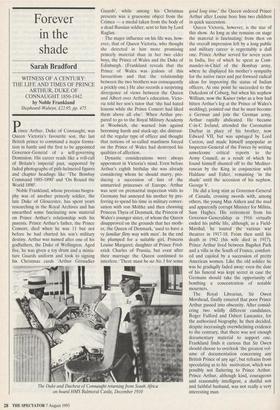Forever in the shade
Sarah Bradford
WITNESS OF A CENTURY: THE LIFE AND TIMES OF PRINCE ARTHUR, DUKE OF CONNAUGHT 1850-1942 by Noble Frankland Shepheard-Walwyn, f2295, pp. 475 Prirince Arthur, Duke of Connaught, was Queen Victoria's favourite son, the last British prince to command a major forma- tion in battle and the first to be appointed Governor-General of a self-governing Dominion. His career reads like a roll-call of Britain's imperial past, supported by faded photographs of pith-helmeted figures and chapter headings like 'The Bombay Command 1885-1890' and 'On Round the World 1890'.
Noble Frankland, whose previous biogra- phy was of another princely soldier, the late Duke of Gloucester, has spent years researching in the Royal Archives and has unearthed some fascinating new material on Prince Arthur's relationship with his parents. Prince Arthur's father, the Prince Consort, died when he was 11 but not before he had charted his son's military destiny. Arthur was named after one of his godfathers, the Duke of Wellington. Aged five, he was given a toy drum and a minia- ture Guards uniform and took to signing his Christmas cards 'Arthur Grenadier Guards', while among his Christmas presents was a gruesome object from the Crimea — a medal taken from the body of a dead Russian soldier, sent to him by Lord Raglan.
The major influence on his life was, how- ever, that of Queen Victoria, who thought she detected in him more promising princely material than in her two elder boys, the Prince of Wales and the Duke of Edinburgh. (Frankland reveals that the Prince of Wales was jealous of this favouritism and that the relationship between the two brothers was consequently a prickly one.) He also records a surprising divergence of views between the Queen and Albert over Arthur's education. Victo- ria told her son's tutor that 'she had hated lessons while the Prince Consort had liked them above all else'. When Arthur pre- pared to go to the Royal Military Academy at Woolwich, she warned him against becoming harsh and stuck-up; she distrust- ed the regular type of officer and thought that notions of so-called manliness forced on the Prince of Wales had destroyed his qualities of affection.
Dynastic considerations were always uppermost in Victoria's mind. Even before Arthur's eighth birthday she was already considering whom he should many, pro- ducing a succession of lists of the unmarried princesses of Europe. Arthur was sent on premarital inspection visits to Germany but annoyed his mother by pre- ferring to spend his time in military conver- sation with von Moltke and then choosing Princess Thyra of Denmark, the Princess of Wales's younger sister, of whom the Queen disapproved on the grounds that her moth- er, the Queen of Denmark, 'used to have a vy familiar flirty way with men'. In the end he plumped for a suitable girl, Princess Louise Margaret, daughter of Prince Fred- erick Charles of Prussia, but even after their marriage the Queen continued to interfere. 'There must be no No 3 for some I he Duke and Duchess of Connaught returning from South Africa on board HMS Balmoral Castle, December 1910 good long time,' the Queen ordered Prince Arthur after Louise bore him two children in quick succession.
Queen Victoria, however, is the star of this show. As long as she remains on stage the material is fascinating; from then on the overall impression left by a long public and military career is regrettably a dull one. Prince Arthur served for seven years in India, five of which he spent as Com- mander-in-Chief of the Bombay army, where he displayed his mother's sympathy for the native races and put forward radical ideas for improving the status of Indian officers. At one point he succeeded to the Dukedom of Coburg, but when his nephew William, now the Kaiser (who as a boy had bitten Arthur's leg at the Prince of Wales's wedding), pointed out that he must become a German and join the German army, Arthur rapidly abdicated. He became C-in-C Ireland, attended the Coronation Durbar in place of his brother, now Edward VII, but was upstaged by Lord Curzon, and made himself unpopular as- Inspector-General of the Forces by writing unwelcome critical reports to the Army Council, as a result of which he found himself shunted off to the Mediter- ranean by the King in conjunction with Haldane and Esher, remaining 'in the shade' until the accession of his nephew, George V.
He did a long stint as Governor-General of Canada, crossing swords with, among others, the young Max Aitken and the mad and apparently corrupt Minister for Militia, Sam Hughes. His retirement from his Governor-Generalship in 1916 virtually ended his public life, although, as a Field- Marshal, he toured the various war theatres in 1917-18. From then until his death in 1942 (his wife died in 1917), Prince Arthur lived between Bagshot Park and a villa in the South of France, comfort- ed and cajoled by a succession of pretty American women. Like the old soldier he was he gradually faded away: even the date of his funeral was kept secret in case the Germans should take the opportunity of bombing a concentration of notable mourners.
The Royal Librarian, Sir Owen Morshead, finally ensured that poor Prince Arthur passed into obscurity. After consid- ering two wildly different candidates, Roger Fulford and Osbert Lancaster, for the authorised biography, he then decided, despite increasingly overwhelming evidence to the contrary, that there was not enough documentary material to support one. Frankland finds it curious that Sir Owen should choose to overlook 'the greatest vol- ume of documentation concerning any British Prince of any age', but refrains from speculating as to his motivation, which was possibly not flattering to Prince Arthur. Prince Arthur, although kind, courageous and reasonably intelligent, a dutiful son and faithful husband, was not really a very interesting man.


















































 Previous page
Previous page